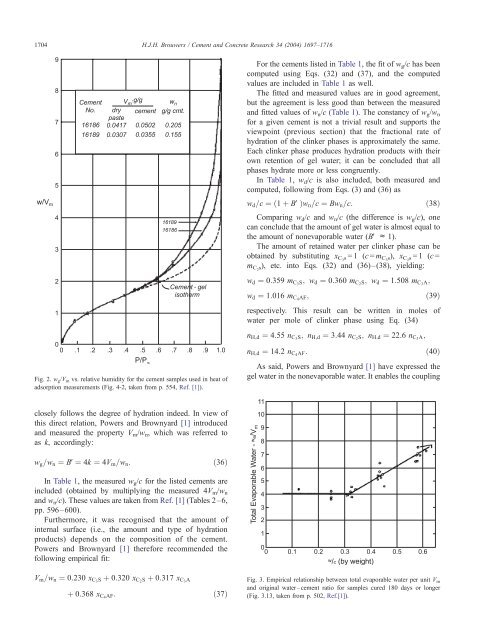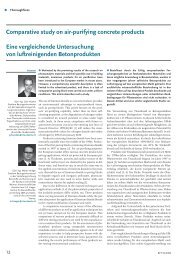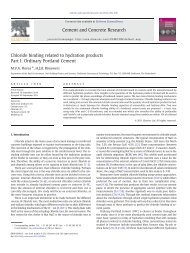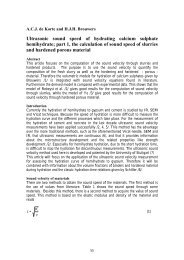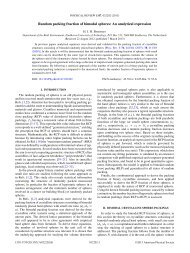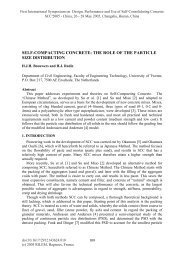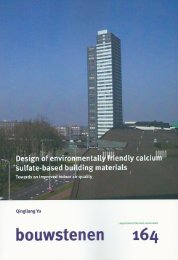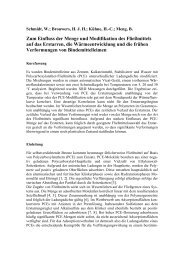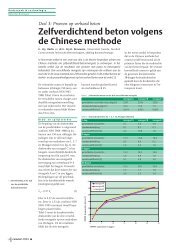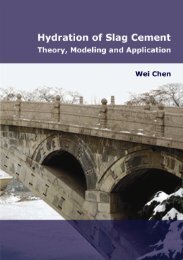1704H.J.H. <strong>Brouwers</strong> / Cement <strong>and</strong> Concrete Research 34 (2004) 1697–1716For the cements listed in Table 1, the fit <strong>of</strong> w g /c has beencomputed using Eqs. (32) <strong>and</strong> (37), <strong>and</strong> the computedvalues are included in Table 1 as well.<strong>The</strong> fitted <strong>and</strong> measured values are in good agreement,but the agreement is less good than between the measured<strong>and</strong> fitted values <strong>of</strong> w n /c (Table 1). <strong>The</strong> constancy <strong>of</strong> w g /w nfor a given cement is not a trivial result <strong>and</strong> supports theviewpoint (previous section) that the fractional rate <strong>of</strong>hydration <strong>of</strong> the clinker phases is approximately the same.Each clinker phase produces hydration products with theirown retention <strong>of</strong> gel water; it can be concluded that allphases hydrate more or less congruently.In Table 1, w d /c is also included, both measured <strong>and</strong>computed, following from Eqs. (3) <strong>and</strong> (36) asw d =c ¼ð1 þ BVÞw n =c ¼ Bw n =c:ð38ÞComparing w d /c <strong>and</strong> w n /c (the difference is w g /c), onecan conclude that the amount <strong>of</strong> gel water is almost equal tothe amount <strong>of</strong> nonevaporable water (BV c 1).<strong>The</strong> amount <strong>of</strong> retained water per clinker phase can beobtained by substituting x C3 s =1 (c = m C3 s), x C2 s =1 (c =m C2 s), etc. into Eqs. (32) <strong>and</strong> (36)–(38), yielding:w d ¼ 0:359 m C3 S; w d ¼ 0:360 m C2 S; w d ¼ 1:508 m C3 A;w d ¼ 1:016 m C4 AF;ð39Þrespectively. This result can be written in moles <strong>of</strong>water per mole <strong>of</strong> clinker phase using Eq. (34)n H;d ¼ 4:55 n C3 S; n H;d ¼ 3:44 n C2 S; n H;d ¼ 22:6 n C3 A;Fig. 2. w g /V m vs. relative humidity for the cement samples used in heat <strong>of</strong>adsorption measurements (Fig. 4-2, taken from p. 554, Ref. [1]).n H;d ¼ 14:2 n C4 AF:ð40ÞAs said, <strong>Powers</strong> <strong>and</strong> <strong>Brownyard</strong> [1] have expressed thegel water in the nonevaporable water. It enables the couplingclosely follows the degree <strong>of</strong> hydration indeed. In view <strong>of</strong>this direct relation, <strong>Powers</strong> <strong>and</strong> <strong>Brownyard</strong> [1] introduced<strong>and</strong> measured the property V m /w n , which was referred toas k, accordingly:w g =w n ¼ BV¼ 4k ¼ 4V m =w n :ð36ÞIn Table 1, the measured w g /c for the listed cements areincluded (obtained by multiplying the measured 4V m /w n<strong>and</strong> w n /c). <strong>The</strong>se values are taken from Ref. [1] (Tables 2–6,pp. 596–600).Furthermore, it was recognised that the amount <strong>of</strong>internal surface (i.e., the amount <strong>and</strong> type <strong>of</strong> hydrationproducts) depends on the composition <strong>of</strong> the cement.<strong>Powers</strong> <strong>and</strong> <strong>Brownyard</strong> [1] therefore recommended thefollowing empirical fit:V m =w n ¼ 0:230 x C3 S þ 0:320 x C2 S þ 0:317 x C3 Aþ 0:368 x C4 AF:ð37ÞFig. 3. Empirical relationship between total evaporable water per unit V m<strong>and</strong> original water –cement ratio for samples cured 180 days or longer(Fig. 3.13, taken from p. 502, Ref.[1]).
H.J.H. <strong>Brouwers</strong> / Cement <strong>and</strong> Concrete Research 34 (2004) 1697–1716 1705<strong>of</strong> gel water (<strong>and</strong> hence, total retained water) to nonevaporableFor the saturated system, Eqs. (41)–(44) will be usedþ 6:96 n C4 AF þ 1:97 n : C¯S ð44Þ directly related to the clinker composition <strong>of</strong> cement (seeEqs. (32) <strong>and</strong> (37) or (43)).water, also when complete hydration is not attained henceforth.(i.e., the actual w n /c being smaller than w n /c required forcomplete hydration, e.g., as predicted by Eq. (32)). For a 3.3. Chemical shrinkagepure clinker phase, the total retained water can be expressedin the mass <strong>of</strong> or moles <strong>of</strong> such phase (by substituting x =1into Eqs. (32) <strong>and</strong> (37)). For cements that consist <strong>of</strong> severalclinker phases, w d can, however, not be expressed in terms<strong>of</strong> the mass fraction <strong>and</strong> number <strong>of</strong> moles <strong>of</strong> clinker phases(likewise, Eq. (32)), which is a disadvantage <strong>of</strong> the chosenapproach. Furthermore, the total retained water could alsodepend on the CS¯H 2 content, thus, it desirable to includethis mass fraction in a fit as well. Accordingly, a leastsquaresmethod is employed to the experimental data <strong>of</strong>Table 1 to obtainw d =c ¼ 0:334 x C3 S þ 0:374 x C2 S þ 1:410 x C3 ATo complete the model, the specific volumes <strong>of</strong> nonevaporable<strong>and</strong> gel water, m n <strong>and</strong> m g , which might both becompressed, also need to be specified. Both properties affectthe shrinkage <strong>of</strong> the paste <strong>and</strong> possible uptake <strong>of</strong> water.<strong>Powers</strong> <strong>and</strong> <strong>Brownyard</strong> [1] measured the specific volume <strong>of</strong>saturated samples using a pycnometer method, with water asthe displacement medium. In Appendix A, this <strong>work</strong> issummarised, <strong>and</strong> it is shown that the results are in agreementwith later <strong>work</strong> on this topic by Copel<strong>and</strong> <strong>and</strong> Hayes [24]<strong>and</strong> Copel<strong>and</strong> [25].<strong>The</strong> specific volume <strong>of</strong> nonevaporable water, m n , wasfound to be 0.72 cm 3 /g <strong>and</strong> did not vary that much for allþ 0:471 x C4 AF þ 0:261 x C¯S:ð41Þ cements. Accordingly, one can use this value for assessingthe specific volumes <strong>of</strong> all reaction products, including C-S-Likewise, as for the nonevaporable water, for the saturatedstate, now, the retained moles <strong>of</strong> water can beexpressed in moles <strong>of</strong> the clinker phases as well usingEqs. (33) <strong>and</strong> (34)n H;d ¼ 4:23 n C3 S þ 3:58 n C2 S þ 21:1 n C3 AH (next section), the most abundant product. Furthermore,from the crystalline reaction products, the specific volumesat different water incorporations are known. This informationconfirms that m n = 0.72 cm 3 /g is a correct value for allhydration products [15].<strong>The</strong> specific volume <strong>of</strong> the gel water <strong>and</strong> its possibleþ 12:7 n C4 AF þ 1:97 n C¯S:ð42Þ compression (to 0.90 cm 3 /g) has been subject <strong>of</strong> discussion[1,9,24,25], <strong>and</strong> up to now, the appropriate value <strong>of</strong> theIn Eq. (41), the mass fraction <strong>of</strong> CS¯ appears; if the masseffective specific volume is not decisively determined. But<strong>of</strong> gypsum (CS¯H 2 ) had been used as the fit parameter, theas we will see, for the crystalline reaction products, theappropriate coefficient would be 0.207 (Eq. (42) obviouslyspecific volumes are known, <strong>and</strong> m g can be determined,would be unaltered). Note that the calcium sulphates reactyielding 0.90 cm 3 /g [15]. In addition, also for the C-S-H,much faster that the other four clinker minerals, but that thethere are two indications that the adsorbed (gel) water isformation <strong>of</strong> ultimate gypsum containing hydration productscompressed to 0.90 cm 3 /g.follows the hydration <strong>of</strong> the four major clinker phases, inFirst, Table 1 shows the chemical shrinkage <strong>of</strong> theparticular, the C 3 A (as we will see in [15]).cements using Eqs. (11), (32) <strong>and</strong> (36)–(38), computedFor each individual clinker phase, one can see that Eqs.with m n = 0.72 cm 3 /g <strong>and</strong> both with m g = 1 (uncompressed)(41) <strong>and</strong> (42) yield very similar values as provided by Eqs.<strong>and</strong> 0.9 cm 3 /g (compressed). This shrinkage is expressed in(9) <strong>and</strong> (10), respectively, although the former fit is based onmass <strong>of</strong> imbibed water per mass <strong>of</strong> hydrated cement.data for 39 cements <strong>and</strong> the latter on more than 100Obviously, when the gel water is also compressed, shrinkageis largest. This larger imbibition <strong>of</strong> CEM I paste wascements. In Table 1, w d /c computed via with Eq. (41) isalso included. For all cements in Table 1, both Eq. (41) <strong>and</strong>studied <strong>and</strong> measured in detail by Czernin [26] <strong>and</strong> Tazawathe combination <strong>of</strong> Eqs. (32) <strong>and</strong> (32) <strong>and</strong> (36) (37) (38)et al. [27]. <strong>The</strong> first author found V s /m w c c 0.06 after 28provide values that are close to each other <strong>and</strong> are in gooddays hydration, although its numerical value was still risingagreement with the experimental values. Eqs. (41) <strong>and</strong> (42)(hydration was far from completed); Tazawa et al. [27]have as advantage that they provide the mass <strong>and</strong> moles <strong>of</strong>measured V s /m w c c 0.05 after 28 days <strong>of</strong> hydration. <strong>Powers</strong>totally retained water as a function <strong>of</strong> each clinker phase,<strong>and</strong> <strong>Brownyard</strong> (Ref. [1], p. 266) mention a typical imbibition<strong>of</strong> 8.2 g water/100 g <strong>of</strong> reacted cement (V s /m w c = 0.082).including calcium-sulphate. <strong>The</strong> mass <strong>and</strong> moles <strong>of</strong> gelwater follow from subtracting Eq. (32) from Eq. (41) <strong>and</strong>From Table 1, it follows that when the gel water isEq. (35) from Eq. (42), respectively:compressed, these measured imbibitions are better matched.w g =c ¼ 0:147 x C3 S þ 0:216 x C2 S þ 0:745 x C3 Aþ 0:258 x C4 AF þ 0:261 x ; C¯S ð43ÞNote that the values <strong>of</strong> m n <strong>and</strong> m g do not depend on thecontent <strong>of</strong> clinker phases <strong>and</strong> seem to hold for all hydrationproducts, although the shrinkage, as such, is obviously notthe same for all cements. <strong>The</strong> reason is that the magnitude <strong>of</strong>n H;g ¼ 1:86 n C3 S þ 2:07 n C2 S þ 11:1 n C3 Ashrinkage is also governed by w n <strong>and</strong> w g , which, in turn, are


